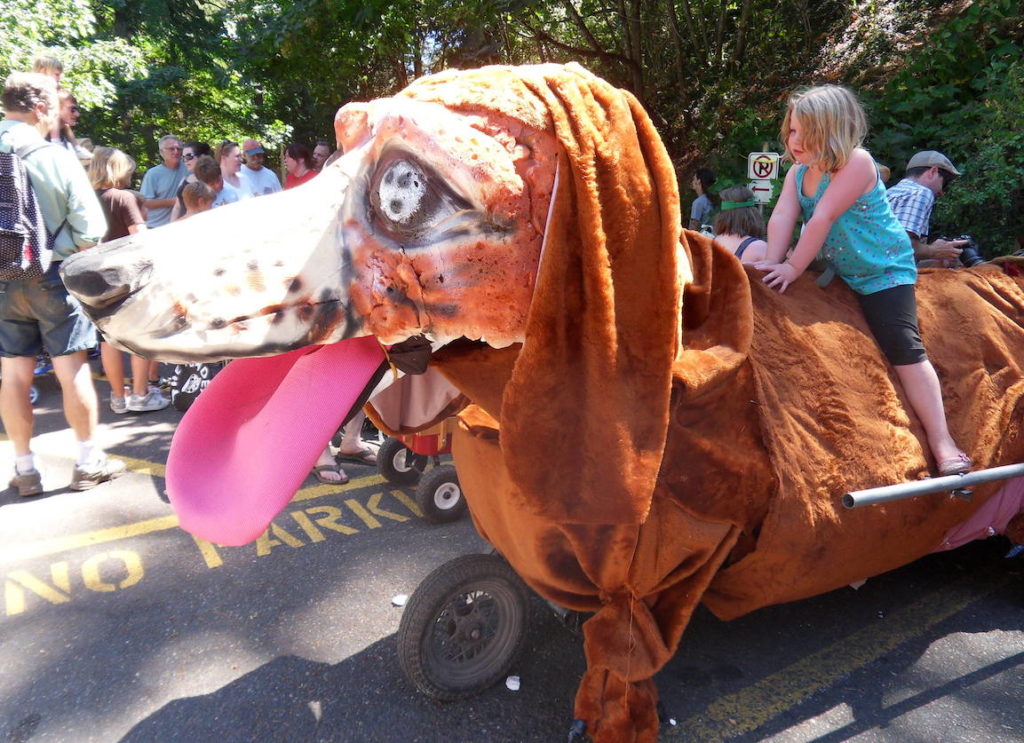
Portlanders love to express themselves artistically, whether through a special outfit, unusual yard art, or building a giant dachshund and racing it down a volcano in the PDX Adult Soapbox Derby. Photo by Teresa Bergen
By Teresa Bergen
When I first moved to Portland, Oregon, in the early 1990s, one of my first friends was a man who self-published a high-brow zine about amusement park rides. He eschewed car ownership, although he was happy to ride in mine. When we played Scrabble, he favored long, obscure words over point value. I can’t remember what he did for a living.
For all of my friend’s quirks, he turned out to be a surprisingly typical Portlander. Everybody seemed to have multiple eccentricities and favored originality and pizazz over income generation. This translated into a city where odd businesses, bands and art installations constantly sprang up and disappeared. There was always something to do. Much of the country and even the world was charmed by this odd place where you could see a bagpiper on a unicycle or buy a Nyquil-filled donut (until the Food and Drug Administration banned the pastry). Those who found Portland too self-consciously hip could laugh at its liberal excesses as immortalized in Portlandia.
But these days, Portland has acquired a layer of grit. Instead of stumbling upon a fire dancer around every corner, you’re more likely to find a muttering homeless man swinging a giant stick. Parts of downtown still haven’t come back from the relentless assault of violent protests, drug crimes and filthy encampments. The Old Town area still is overrun with drug zombies. Homeless camps and boarded-up buildings covered with graffiti dot the whole city. These range from a single tent pitched on a residential street to blocks of tents and derelict RVs surrounded by trash piles. Some of these stretch for blocks, both in the inner city and on the edges of Portland.
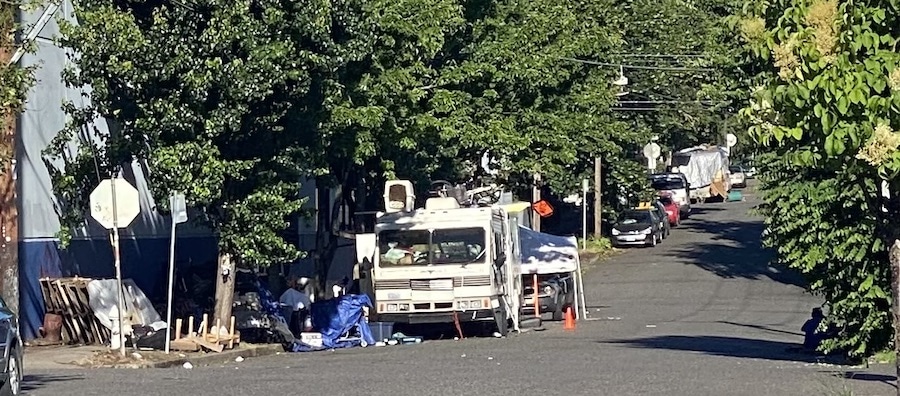
A typical Portland homeless campsite makes the sidewalk impassable for women and children and unpleasant for men. Lack of sanitation, mental health issues and infrequent law enforcement make clusters of blue tents dangerous for people passing by. Photo by Teresa Bergen
Does the promise of Portlandia live on? For the sake of journalism, I decided to take an unflinching look at my city. Here’s what I found on a few weeks of random wandering.
A Stroll down SE Division Street
I started my investigation on Southeast Division Street, which over the last two decades has gone from sleepy and a little rundown to a booming commercial strip full of trendy places to eat and shop. It once bore the even less catchy name Section Line Road, with both names referring to 19th-century division of land parcels. But now Portland’s hip gentrification encompasses the street.
On a sunny Saturday afternoon, Division looked clean and upbeat. Most businesses survived the pandemic. I saw no tents and nobody obviously suffering from a mental health crisis. Instead, shops and shoppers, restaurants and diners. This is an especially good place if you’re hungry for dessert. You can line up for a cone at Salt & Straw, Portland’s most famous ice cream purveyor, or pie at Lauretta Jean’s. Other popular dessert options here include Blue Star Donuts, Pinolo Gelato, and my favorite, Eb & Bean, which is a wizard at dairy and non-dairy soft serve.
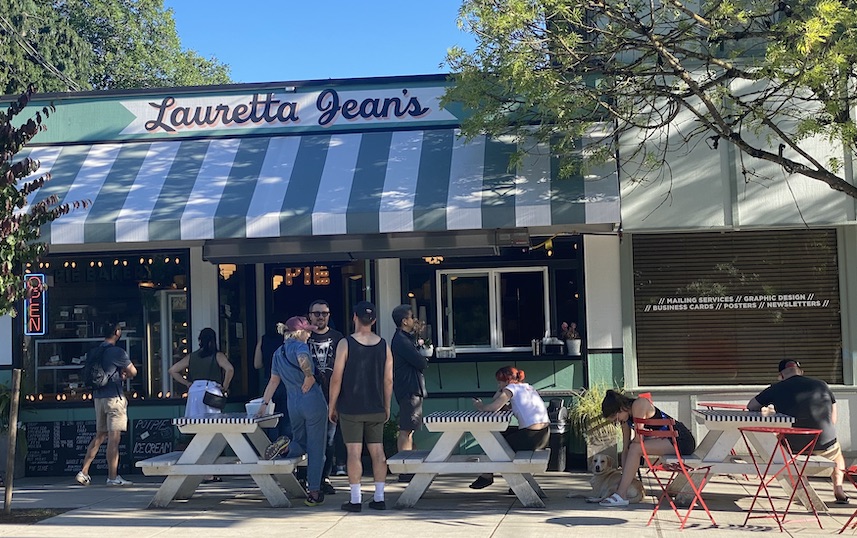
People wait for pie in front of Lauretta Jean’s on SE Division Street. Photo by Teresa Bergen
Portlanders love to get intoxicated and options dot Division Street. In addition to the expected bars and pot shops, there’s Clean Kratom, which bills itself as “America’s first and largest kratom dispensary,” and the Bula Kava House, Portland’s only kava bar. Kratom is a controversial ingredient from Southeast Asian trees which produces opioid effects, while kava is from a South Pacific plant, brewed into a drink known for relaxation.
In other Division Street vice news, you can visit the female-centered sex toy shop She Bop. As I examined a midnight blue dildo, a worker enthused about sex toy diversity. “They used to just be that pinkish color,” she said, eyes sparkling under their silver-glittered lids. “Now there’s much more inclusion. And they use vegetable dye, so they’re vegan-friendly.”
Market Segments
Division Street has quite a few boutiques of the how-on-earth-do-they-stay-in-business variety. Spacious stores sell mostly candles or air plants or things to make your condo smell good. Carter + Rose specializes in tiny plants and fragile ceramic snakes and has been in business for six years, surviving the pandemic with online sales. There’s even a Pride Snake Collection, featuring rainbow-dotted serpents.
I had a real Portland moment at the resale store Artifact. When the clerk rang up my armload of dresses, I asked for a bag. “Oh, we went bagless to reduce waste,” said the cashier. Already the silky belts of my secondhand wrap dresses were slithering to the floor. “But I’m still walking a couple of miles and have other stops to make,” I protested.
The clerk held up the line to scour the store for a bag. Finally, finding a small paper sack, he encouraged me to stuff my purchases in “like a burrito.” Then he cheerfully invited me to drop off any extra bags in the future for other shoppers, and to also bring other plastic packaging that they would recycle.
Selling stuff but denying shoppers bags on account of the environment is a microcosm of Portland’s problematic charm. Like building upscale condos without parking and saying all those folks would be happy biking and taking the bus. Nice in theory, but…
A Walkabout in East Portland
On a rainy night in early summer, an old friend and I took a long ramble around Portland’s East Side. Eric Welsh lives in Plainfield, New Jersey, just outside New York City and had only visited Portland once years before. So I enlisted his help to see the city through new eyes. His verdict? “I want to move here!”
He’d been staying downtown all week while he worked a court case, but had moved to my side of the river for his last nights in Portland and was reveling in his choice of Tiny Digs, one of Portland’s miniature house hotels. Each dwelling is different. Eric’s was a tiny white Victorian cottage, complete with a front porch and an upstairs sleeping loft. Other tiny digs include a mini barn, a caboose, and a sleek modern unit straight out of a Scandinavian design magazine.
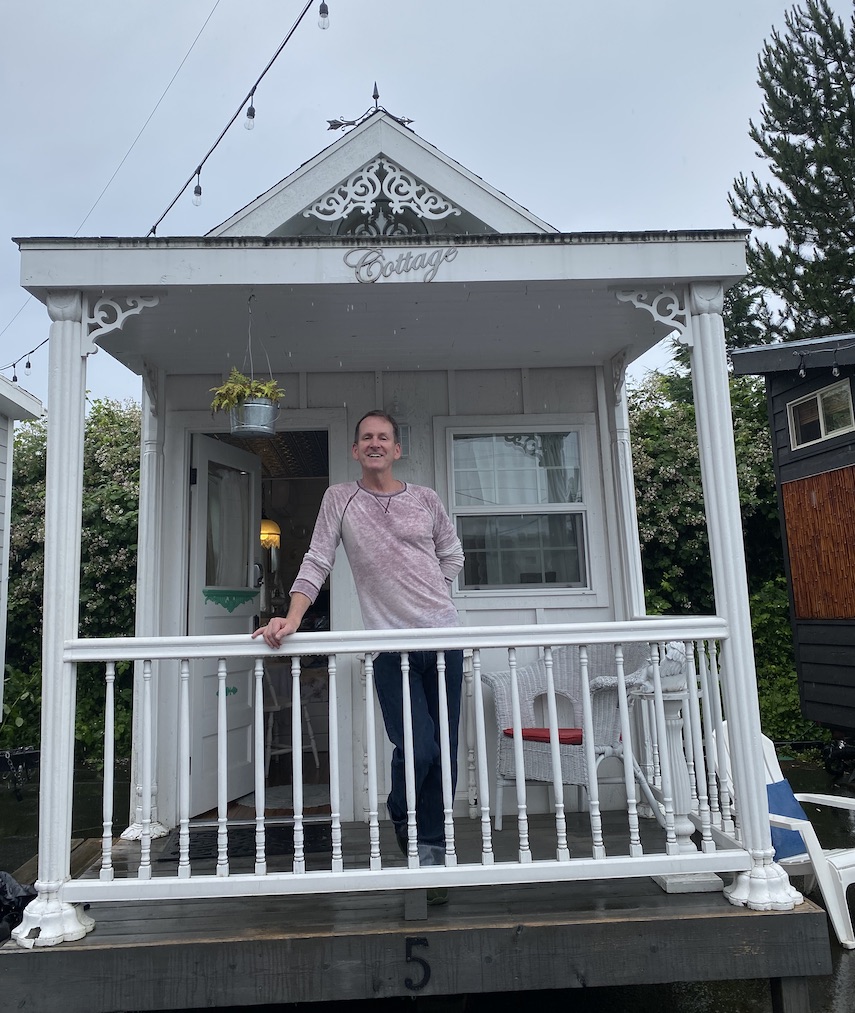
Eric Welsh at Tiny Digs tiny house hotel. Photo by Teresa Bergen
In our texts regarding the outing, Eric mentioned an art opening. “Are you into trans men?” he texted me. Well, that might be overstating my attitude, but I was game to check out the show. It was the kickoff of Pride Weekend, and many young, sharply dressed folks were also attending “Portraits of Them,” a collaboration between Ursa Nüffer-Rodriguez and photographer Holly Haney.
The two met every month for a year as Ursa transformed from outwardly looking like a she to them. Photos of the process covered the walls. There was even a medical specimen bottle containing Ursa’s nipples. Haney, friendly and gorgeous in a diaphanous floral dress, floated around plying art lovers with a tray of rainbow-colored Jell-O shots.
We left the festive scene to walk the residential neighborhoods of inner Southeast Portland. Eric, always interested in real estate, commented on the greenness (thanks, rainy spring) and how quaint every house was. “There are no ugly buildings!” he said.
Perfection Eludes Portland
He was, however, dismayed by the tents that dotted the city. We even encountered one on the roundabout in the middle of a residential street. Eric, like many visitors and residents, was confused about the legality of street camping. “Like I could just put a tent right here?” he asked, gesturing to a nice bit of grass and sidewalk. “I never realized Portland was so affordable!” Joking aside, it’s hard to wrap your mind around the fact that there’s both a shortage of solutions—where are these people going to go—and a lack of police or city workers to move them along. “The tent people are irritating beyond belief,” Eric concluded. Agreed.
Still, not irritating enough to deter him from his Portland dream. We strolled through Lone Fir, one of Portland’s pioneer cemeteries, then cut through hilly Laurelhurst Park, which measures about six by three blocks and is packed with trees, rhododendrons, pedestrian paths and a small lake. We found a paperback book and some Vanity Fair magazines for his plane ride home in one of the many little free libraries people build outside their houses.
Then we walked back along NE 28th, which was full of people getting dinner at its many restaurants. Eric was perplexed by people standing in line for ice cream at Fifty Licks at 8:30. “Isn’t it a little early for ice cream? Isn’t it dinnertime?” he asked. Sorry, pal, this ain’t New York. Most of our restaurants close at nine or ten.
Still, my friend was impressed with Portland’s vibrancy and youthful vibe. And, compared to New York, it seemed friendly and hassle-free to him. “Other cities have a hip neighborhood,” he said. “But here, it’s universal hipness.”
Portland’s famous food carts
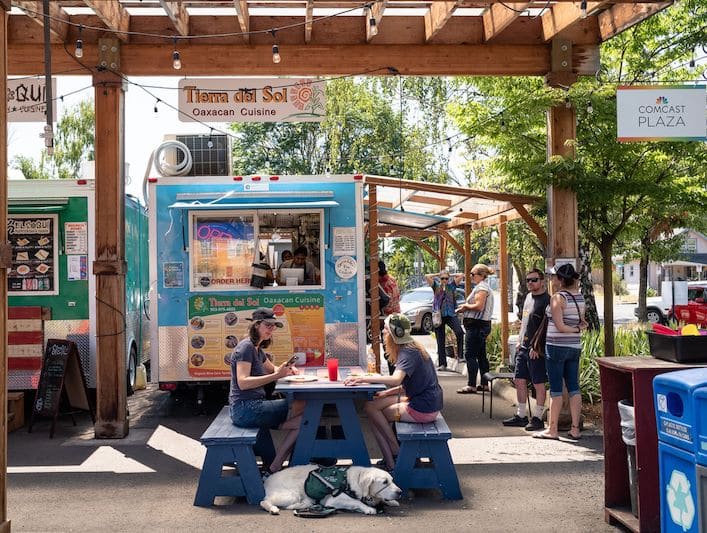
Diners at Portland Mercado. Cuisine from food carts clustered in a pod is delicious and inexpensive. Amenities are sparse but reservations are not required. Photo courtesy of Travel Oregon
Like most places, Portland lost many restaurants during the pandemic, including some of its famous food carts. Or even whole cart pods (that’s a group of food carts in one place). Sadly, Shady Pines, the all-vegan pod, had the bad luck to open months before the pandemic. It’s gone now, although a few carts survived to limp over to new pods.
Carts tend to come and go. Food cart owners often try out unusual or very specific concepts. The public embraces some and kicks others to the curb. In rainy Portland, it’s a challenge to lure people outside to eat year-round. The best pods have amenities like overhangs, outdoor heaters or fire pits and a Porto-potty. Admittedly these don’t really compare to the atmosphere of a real restaurant. But then, that helps keep prices down.
The Hawthorne Asylum has the most creative pod theme. It’s situated not far from Portland’s historic mental health hospital, once run by Dr. James Hawthorne. It has steampunk touches, like the metal gothic arch over the entrance and rusted waste cans shaped like toothy monsters. And where else in Portland can you buy Guyanese food with cryptocurrency?
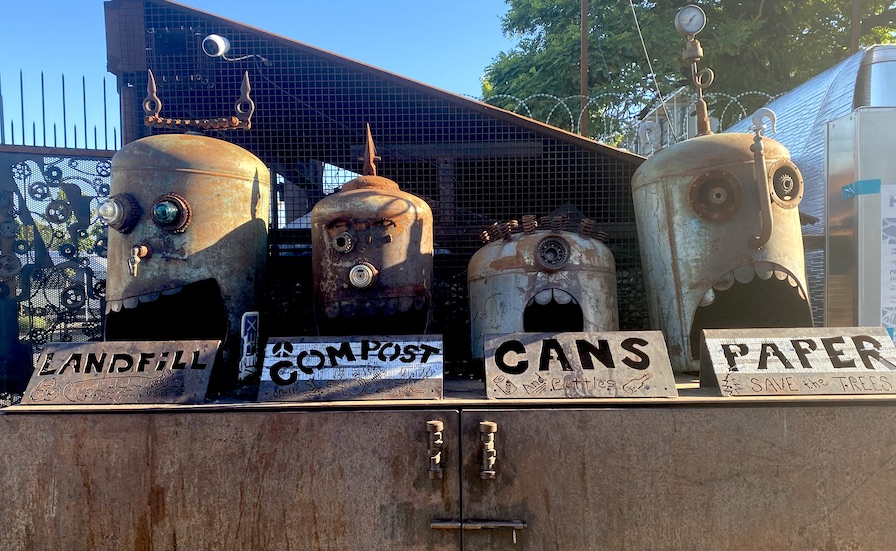
The Hawthorne Asylum takes recycling seriously. Photo by Teresa Bergen
On SE Foster Street, the Portland Mercado’s shades of yellow, pink and turquoise brighten the grayest day. This hub for Latino entrepreneurship features food carts representing Colombia, Chile, Cuba, El Salvador, Argentina and five regions of Mexico. Pick the right day and you’ll even hear mariachi music or Aztec drumming.
Portland’s cart culture is going strong, so foodies who travel to eat won’t be disappointed. Violent protests occasionally occur in my city, but everybody needs to eat, and in Portland people on all sides of an issue eat really well.
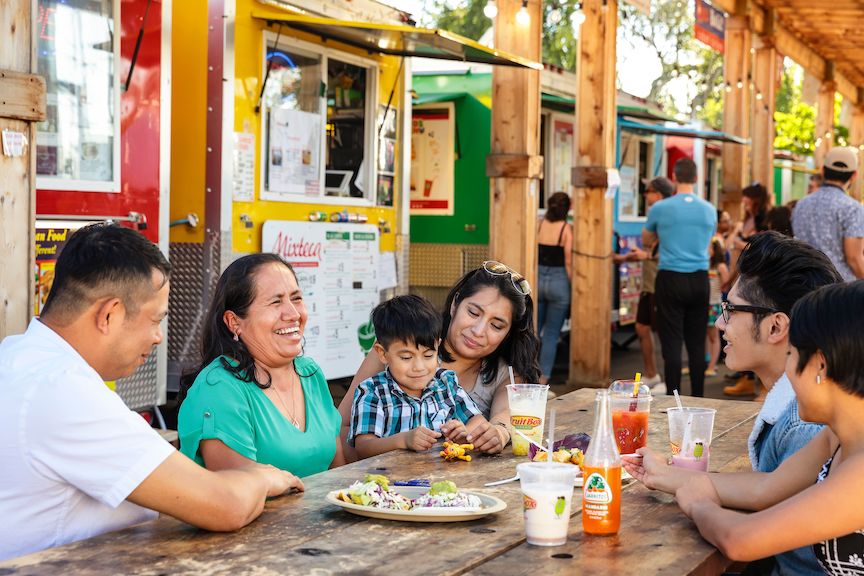
Portland Mercado. Photo courtesy of Travel Oregon
In Summer We Blossom
Portlanders dream of the sun all through the nine-month rainy season. But when it appears, we blink, mole-like, hands over tearing eyes. It hurts. However, we have a moral compulsion to go outside when the sun finally shines. Creativity blossoms with the light, and some of Portland’s most interesting things happen in summer.
Bike-themed Pedalpalooza used to just be in June, but now it encompasses July and August too. This series of more than 100 bike events is open to the public not only to join but to plan. You can click a button on the computer to add your own themed ride.
If you like to show your stuff, join the Full Moon Naked Ride. People who prefer to ride a very short distance while making lots of noise can join the three-minute Ding Ding Ride, ringing their bike bells the whole time. There’s a Teal Ride for those with teal bikes, and a yacht-themed “Come Sail Away” ride.
The PDX Adult Soapbox Derby in August is another cherished summer event. Since 1997, Portlanders come out in droves to watch soapbox racers zoom down the slope of Mount Tabor, a dormant volcano. The cars must have at least three wheels, brakes and a horn. Some designers prioritize speed, while others are all about creativity. Up to ten thousand spectators show up to cheer on entrants shaped like a giant dachshund, a beauty shop on wheels, or whatever else people spent the rainy season imagining.
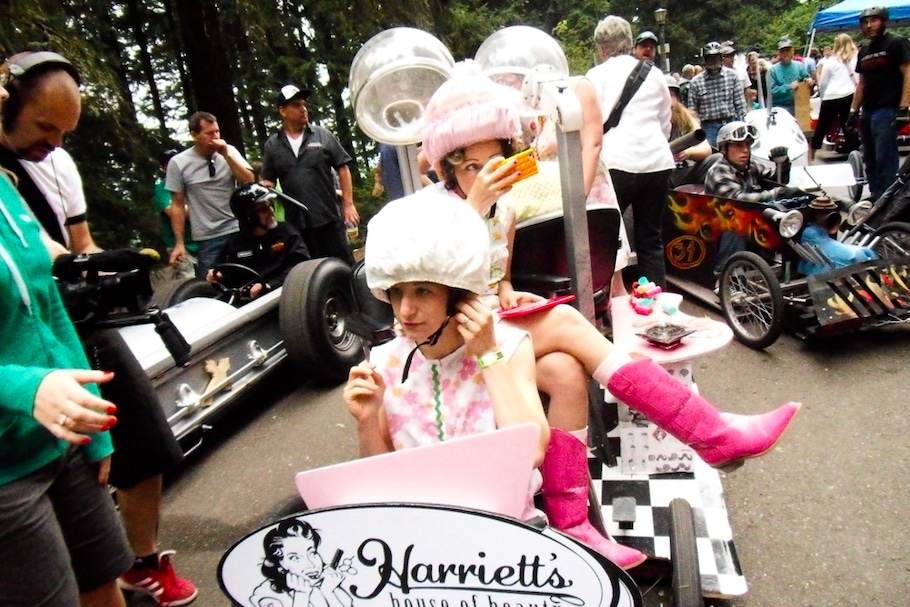
Beauticians prepare to race in the PDX Adult Soapbox Derby. PDX is the code that identifies Portland International Airport. Photo by Teresa Bergen
Then there’s the river. The Willamette, which divides Portland’s east and west sides, warms up enough in summer for swimming and tubing—if you dare. A history of sewage overflows causes many Portlanders to scorn the waterway. But the Human Access Project encourages people to embrace the river with various events. These include The Big Float, an annual beach party in the Willamette, and the River Huggers Swim Team, where experienced swimmers get together in the early morning to swim downtown beneath the Hawthorne Bridge.
Years ago when politics was less contentious, Mayor Ted Wheeler participated in a Swim with the Mayor event. But nowadays he’d probably need mermen bodyguards and bulletproof swim trunks.
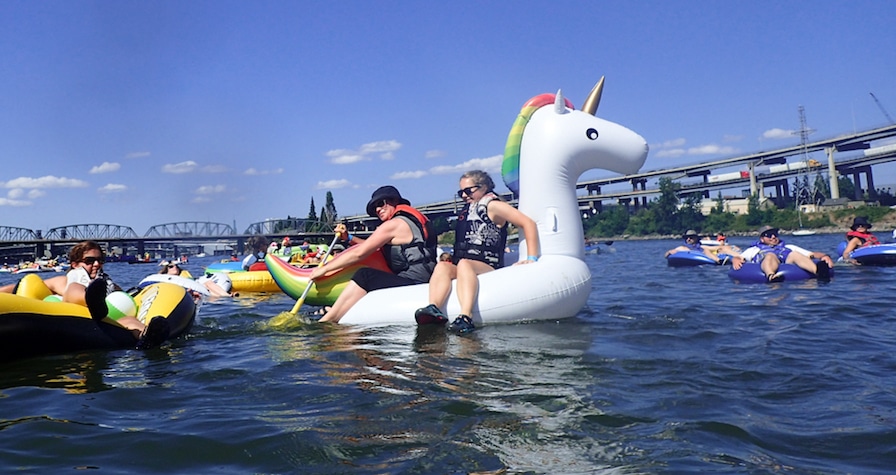
Portlanders blow up their best inflatables for The Big Float. Photo by Teresa Bergen
And, of course, summer brings out the artists and makers in a series of neighborhood fairs, street art galleries, craft shows and festivals. At Boheme PDX, a monthly craft fair under the Fremont Bridge in Northwest Portland, I met Wesley Ballew, a young artist who spent the pandemic traveling around Oregon. “I like to bring home souvenirs,” he said. “But I realized there are so many terrible travel gifts.”
So Ballew started designing his own. He had a minimal art background, so turned to YouTube for coaching on vector art and graphics. He started with a series of Portland bridges since their straight lines made them relatively easy to draw. Now he’s upped his skills to include mountains, rivers, buildings and animals. Today, he produces travel souvenirs full-time. He sells his retro-looking pins, magnets, travel journals and washi tape (decorative masking tape popular with scrapbookers) in shops around Oregon and at festivals.
Ballew’s business Landmarks Unlimited is one of many stories of Portland entrepreneurs not letting a pandemic keep them down. “My goal is to make elevated travel gifts that don’t end up in a junk drawer when you get home.”
Where to Stay and Where to Avoid
Portland is still a town full of creative energy worth visiting. Visitors just need to be a little warier than they have in the past. Unless you have a high tolerance for grit, this is a good time to forego downtown and instead explore the more residential neighborhoods.
My friends who got married in the summer of 2022 sent out excellent but complicated guidance about where their out-of-town guests should stay and where to avoid, which I’ll pass on here. “For Airbnb, I recommend the following neighborhoods: Laurelhurst, Grant Park, North Tabor, Mt. Tabor, Sunnyside, Richmond, South Tabor, Reed, Eastmoreland, Sellwood-Moreland, and Hollywood.
“We recommend guests avoid Downtown, the Lloyd District, East Portland (near the border with Gresham), and anywhere within 10 blocks of the Willamette River.
“Portland is a very safe city in general. However, there are parts that are stressful to navigate, and will not produce the happy memories we want for your trip here. Just trust us.”
I used to walk most places in Portland at all hours, and take public transportation at midnight. I’m a little more careful these days. Consider shelling out for an Uber rather than taking late-night buses.
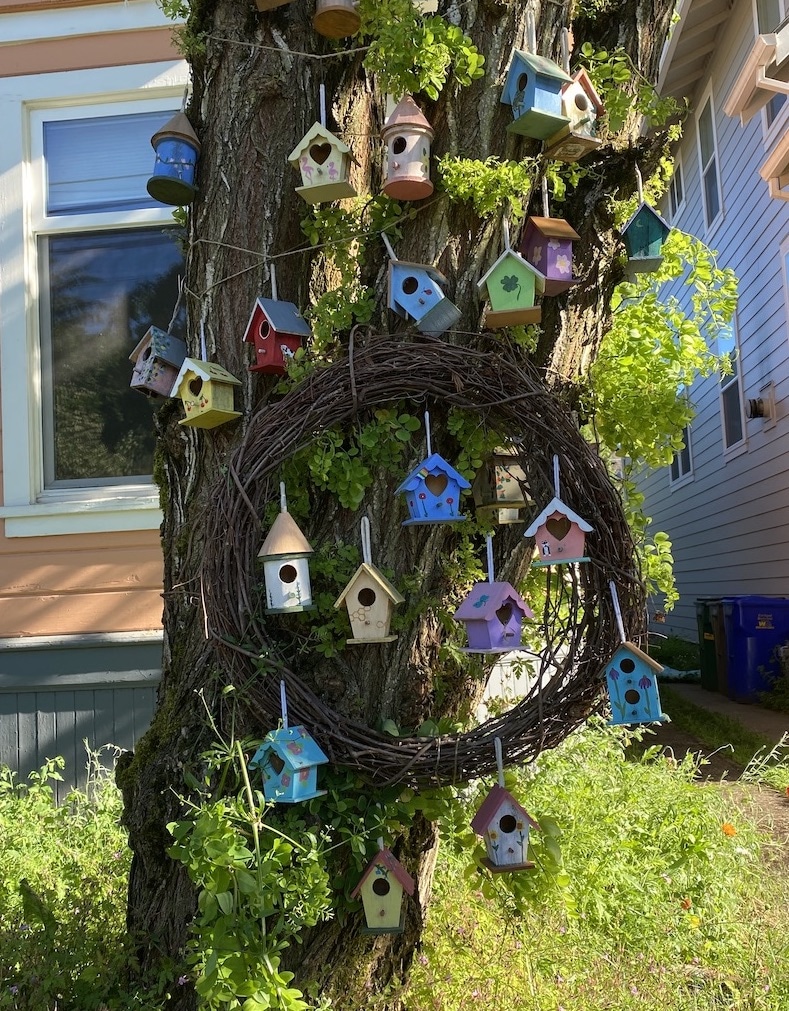
In Portland, there’s room for everybody, even tiny birds, who can find shelter in these tiny bird houses in Southeast Portland. Photo by Teresa Bergen
More Portland than Ever
I had a night out at Suckerpunch, which bills itself as “an experimental zero-proof bar,” with my friend Gretchen Newberry. Gretchen had just moved back to Portland after ten years she spent getting a Ph.D. in South Dakota and then working in Wisconsin.
Despite a decade of wear and tear on her adopted city, she is thrilled to be back, prepared to take the good with the bad and unshakable in her faith in Portland. “It’s a lot denser with traffic and people,” she says. “But that also means more of the cool stuff.” If you like an urban area with lots of restaurants and bars, independent shops and creative people, it’s the place to be.
Bottom line: “It’s more Portland than ever.”
Teresa Bergen is the author of Easy Portland Outdoors and co-author of Historic Cemeteries of Portland, Oregon. A typical Portlander, she is always searching for the best vegan ice cream, swims with the River Hugger Swim Team and once had a business selling costume devil horns.

